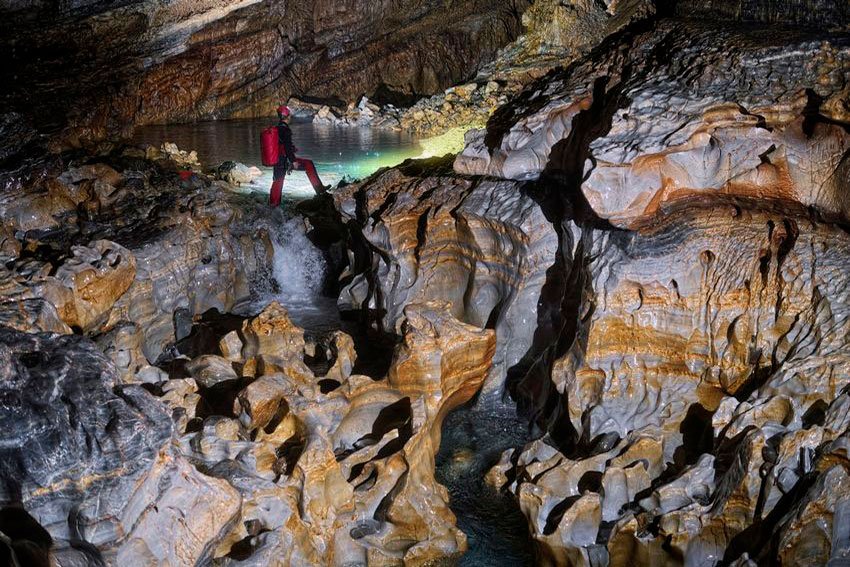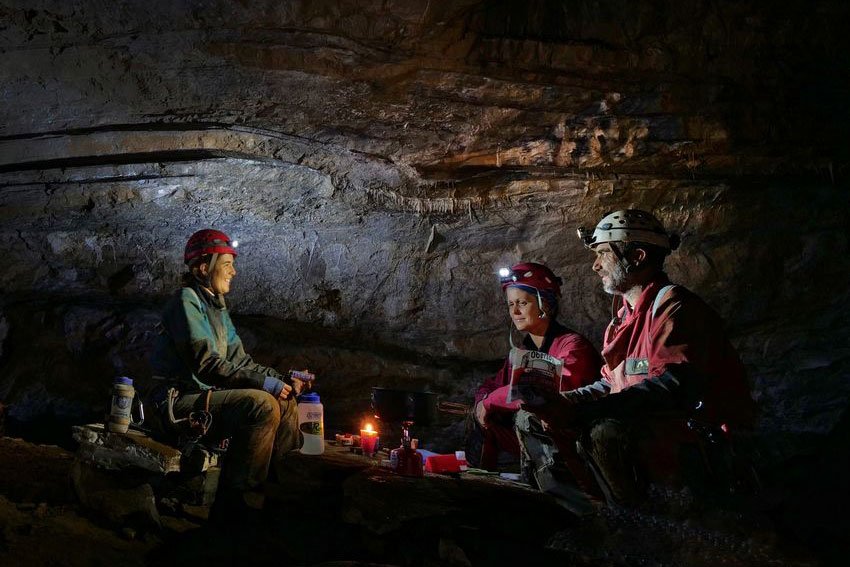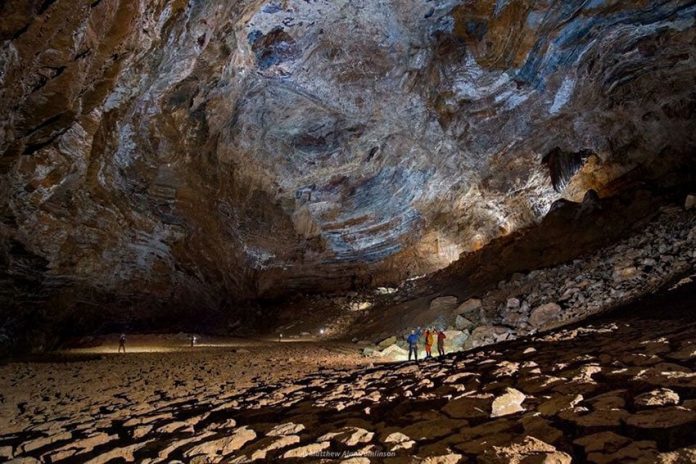For die-hard cave explorers around the world, Mexico has long been considered “the new frontier of caving.” Here cavers have a high likelihood of being among the first human beings ever to boldly set foot where “no one has gone before.”
Maybe the best example of Mexico’s magnificent caves is the Huautla Cave System located in Oaxaca’s Sierra Mazateca. Exploration began in 1965 when a group of cavers from Austin, Texas, arrived at the village of Huautla de Jiménez.
They soon discovered three beautiful and challenging caves in the area: Sótano de San Agustin, La Grieta and Nita Nanta. In time it became clear that these and other caves they kept finding were interconnected, all part of one big cave system, which became known as Sistema Huautla.
Numerous expeditions took place over the years and more than 65 kilometers of passages were mapped by cave explorers from all around the globe. In the late winter of 2013, an international team of cave divers entered the cave, rappelled through crashing waterfalls down chasms as tall as skyscrapers and carried out eight separate scuba dives past “the mother of all sumps” to reach a depth of -1,554 meters, making Huautla the western hemisphere’s deepest cave — and now the longest of the 17 deepest caves in the world.
In 2015, 47 speleologists from seven countries (Mexico, United States, United Kingdom, Australia, Poland, Switzerland and Romania) participated in a six-week expedition to venture into parts of the system which had not yet been explored.

“We mapped and connected two caves 700 meters deep,” said veteran Huautla pioneer and Explorers Club member Bill Steele. “You need a lot more than 700 meters of rope to reach that point because you have horizontal traverses to do on the way down . . . and it takes a whole week just to put the ropes in place.”
In 2014, Steele helped to form PESH (Proyecto Espleleológico Sistema Huautla), a project dedicated to conducting a comprehensive speleological study of Sistema Huautla over a 10-year period.
Recently, I caught up with Steele just after he returned from the latest exploration of Huautla, which took place throughout April.
“Sistema Huautla is now 89 kilometers long,” he told me, “and 1,560 meters deep, which makes it the deepest cave in the western hemisphere and the ninth deepest in the world, tied for that place right now with a cave in Austria. This year we added three entrances to the system, so we’ve got 29 entrances now.”
“This was the sixth PESH expedition,” Steele went on, “and this year we had 42 people. They were from three countries: Mexico, the U.S. and Costa Rica. The way we structure it is we have 30 people at any given time: that’s what our infrastructure on the surface can handle. One thing of note this year is that at one point we had five deep underground camps going at the same time, a new benchmark for exploration in Huautla. These people stayed underground for a week at a time and then came out to report.
“Some of your readers may not realize that there is no radio in existence that works through that much rock, although there are a couple of people working on that sort of thing. So, at the moment, it’s like Pony Express: the way you find out what’s going on is when somebody comes out and tells you.

“And years ago we decided it’s better if these people actually write out their report before heading for the surface, because after climbing up so many ropes and working so hard for so long, people arrive up here so tired that they forget what it was they were supposed to tell you or they can’t quite remember all the details, so we now have a rule that all messages must be written down.”
As for scientific results, this year’s PESH expedition had a graduate student from Western Kentucky University who is studying karst hydrology. “His name is Fernando Hernández,” Steele told me, “and he’s a very good caver. He is still there in Huautla right now. He’s been there since February. In regard to biology, we have a collecting permit issued to us by Dr. Oscar Francke of UNAM in Mexico City. He’s described 48 different life forms that live in Sistema Huautla. Eleven of these have turned out to be highly adapted troglobic creatures.
“As for paleontology, Dr. Iván Alarcón Durán out of Puebla and his people are looking at some remains of Pleistocene megafauna that we’ve seen in the caves. They discovered the only complete skull ever found in Mexico of a Pleistocene sloth over 12,000 years old. So we are really happy about what Mexican cave scientists are finding here.”
The yearly presence of cave explorers in the local villages has had unexpected consequences. This is just one of many anecdotes told by Bill Steele:
“On the very last day of last year’s expedition, a school teacher walked up and he had a USB drive in his hand. Now he was a little shy. He lives in the same village where we rent houses, and he said: ‘This is my life’s work and I’m hoping that you can find a way to print a hundred copies of this to help children learn to read their native language, Mazateco. I teach it, but we don’t have a book. If you can print 100 copies, I would be so happy.’
“So I went back to Texas wondering, ‘How am I going to do that?’ Every page in that teacher’s manuscript was in color . . . and I looked into the cost and sort of gulped, because publishing really isn’t our thing. But I went to the Whole Earth Provision Company, which has been so good to cavers. They had printed our brochure, which explains what we were doing in Huautla.

“That brochure, by the way, is written in three languages: English, Spanish and Mazateco, and we found out that it is the only document in existence in those three languages, other than the Holy Bible! So schoolteachers like it.
“Of course, that teacher knew about the brochure because he is the very one who translated it into Mazateco. So, as for the primer, we said, ‘We’ll do what we can.’
“Well, we did better than 100 copies: we were able to print 180, beautifully done and spiral bound so they lay flat on a desk.”
Back to caving, I asked Bill Steele where Huautla stands in relation to the rest of the world’s caves.
“Well,” replied Steele, “Carlsbad Caverns is known for one very big chamber called the Big Room, but here in Huautla we’ve got at least 12 rooms just as big . . . and one of them is twice the size of the Dallas Cowboys’ stadium! . . .
“You know, way back in 1987, a famous Swiss caver named Phillipe Rouillier approached me deep inside the cave and said, with his German-Swiss accent, ‘Bill, I do believe this is the most magnificent cave on earth.’ Thirty-two years later — after numerous stupendous additions to the cave, I hear more and more speleologists saying the same.
“This was my 25th Huautla expedition over 42 years. I was a young man of 28 the first time I went. Now I am 70 years old. I feel really blessed that I am able to be a part of such a significant exploration of a major geographical feature of this planet. It’s an incredible cave!
Would you like to visit the Huautla caves from your living room, without getting your clothes muddy? Have a look at the PESH page. The pictures are spectacular.
Photos courtesy of PESH and Bill Steele, unless otherwise indicated.
[soliloquy id="80106"]
The writer has lived near Guadalajara, Jalisco, for more than 30 years and is the author of A Guide to West Mexico’s Guachimontones and Surrounding Area and co-author of Outdoors in Western Mexico. More of his writing can be found on his website.
